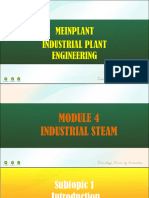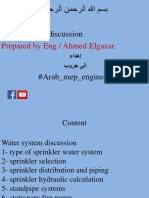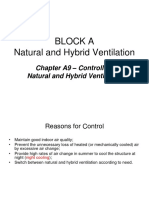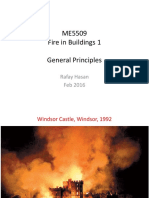0 ratings0% found this document useful (0 votes)
20 viewsFire 3 - Extinguishing Systems: Rafay Hasan
Fire 3 - Extinguishing Systems: Rafay Hasan
Uploaded by
Ali AimranThis document discusses different types of fire extinguishing systems including automatic sprinkler systems, manual systems, and other specialized systems. It describes how basic wet sprinkler systems work by maintaining water pressure and activating pumps and alarms when a sprinkler head is triggered. It also covers sprinkler head spacing, sizing of pipework and tanks, deluge systems, alternate wet-dry systems, water mist systems, foam systems, gas extinguishing systems, and fire hose reels.
Copyright:
© All Rights Reserved
Available Formats
Download as PDF, TXT or read online from Scribd
Fire 3 - Extinguishing Systems: Rafay Hasan
Fire 3 - Extinguishing Systems: Rafay Hasan
Uploaded by
Ali Aimran0 ratings0% found this document useful (0 votes)
20 views14 pagesThis document discusses different types of fire extinguishing systems including automatic sprinkler systems, manual systems, and other specialized systems. It describes how basic wet sprinkler systems work by maintaining water pressure and activating pumps and alarms when a sprinkler head is triggered. It also covers sprinkler head spacing, sizing of pipework and tanks, deluge systems, alternate wet-dry systems, water mist systems, foam systems, gas extinguishing systems, and fire hose reels.
Original Description:
FLD note
Original Title
Lecture 8
Copyright
© © All Rights Reserved
Available Formats
PDF, TXT or read online from Scribd
Share this document
Did you find this document useful?
Is this content inappropriate?
This document discusses different types of fire extinguishing systems including automatic sprinkler systems, manual systems, and other specialized systems. It describes how basic wet sprinkler systems work by maintaining water pressure and activating pumps and alarms when a sprinkler head is triggered. It also covers sprinkler head spacing, sizing of pipework and tanks, deluge systems, alternate wet-dry systems, water mist systems, foam systems, gas extinguishing systems, and fire hose reels.
Copyright:
© All Rights Reserved
Available Formats
Download as PDF, TXT or read online from Scribd
Download as pdf or txt
0 ratings0% found this document useful (0 votes)
20 views14 pagesFire 3 - Extinguishing Systems: Rafay Hasan
Fire 3 - Extinguishing Systems: Rafay Hasan
Uploaded by
Ali AimranThis document discusses different types of fire extinguishing systems including automatic sprinkler systems, manual systems, and other specialized systems. It describes how basic wet sprinkler systems work by maintaining water pressure and activating pumps and alarms when a sprinkler head is triggered. It also covers sprinkler head spacing, sizing of pipework and tanks, deluge systems, alternate wet-dry systems, water mist systems, foam systems, gas extinguishing systems, and fire hose reels.
Copyright:
© All Rights Reserved
Available Formats
Download as PDF, TXT or read online from Scribd
Download as pdf or txt
You are on page 1of 14
Fire 3 Extinguishing Systems
Rafay Hasan
Extinguishers available
Automatic
Sprinkler Systems (water)
Foam
Gas
Manual Systems (First Aid)
Hose reels (water)
Portable (water, foam, powder, gas, chemical)
Frangible bulb
deflector
Basic sprinkler
system
wet system
Always fully charged with water
Pressure maintained using jockey pump
Drop of pressure on sprinkler head operating
Main pumps start
Alarm bell activated
FDA activated
More heads operate if fire spreads
Extinguishes or limits growth of fire by cooling the
burning/pyrolysing material
Sprinkler head spacing
Rectangular or staggered layout
Maximum floor area covered per head depending on hazard
classification
Maximum linear distance between heads and distance from walls
Need to consider down beams and ductwork obstructions
Needs careful integration within ceiling plan and other services (eg
lighting)
Maximum number of heads per system
sizing
Pipework and pumps sized to achieve water
design water flow rate (typically 5-10 L/s)
Tanks sized to provide this flow rate for a
minimum period of time (typically 1 hours)
Design flow rate based on Hazard
Classification
(Sizing dealt with later)
Deluge- for high risk areas
Permanently open drencher
heads so all operate
simultaneously when
deluge valve opens
Alternate Wet-Dry
Used where risk of freezing during winter
In summer, operates as normal wet system
In winter, water drained and replaced with
pressurised air on operation of sprinkler
head, system charged with water
Water Mist
Conventional sprinkler
head
Water mist sprinkler head
Water mist
Very fine droplets rapidly evaporated by heat
of fire to form steam:
Cools burning material
Absorbs radiant heat
Cools smoke/flame
displaces combustion air
Reduces amount of water required
Use wet or deluge system
Foam systems
Displaces combustion air
Little cooling potential
Useful for flammable liquid fires
Gas Extinguishing Systems
Halocarbons - displace combustion air and may inhibit burning
Inert gases displace combustion air
Both dangerous to people (suffocation)
Fire Hose Reels
Can be used by occupants or fire
brigade
Not recommended by some fire
authorities risk to user
Locate in a protected fire escape
You might also like
- Marine Piping SystemDocument75 pagesMarine Piping SystemNguyễn Hoàng Thành100% (1)
- Fire Control Systems PDFDocument44 pagesFire Control Systems PDFMukhammadjon100% (1)
- Fire Fighting SystemDocument29 pagesFire Fighting SystemAnonymous F3Ekm6HBs67% (3)
- 02 - Fire Water Demand and ApparatusDocument49 pages02 - Fire Water Demand and ApparatusAnnisa100% (1)
- 100 Things Every Homeowner Must KnowFrom Everand100 Things Every Homeowner Must KnowFamily HandymanNo ratings yet
- Sap Charm: (Solution Manager 7.2)Document17 pagesSap Charm: (Solution Manager 7.2)Krishna Vamshi50% (2)
- Water-Based Fire Protection Systems & EquipmentDocument24 pagesWater-Based Fire Protection Systems & EquipmentMuhammad Faiz bin Ahmad ShafiNo ratings yet
- 01 Water Suppression SystemDocument54 pages01 Water Suppression SystemKolos Char YiuNo ratings yet
- Chap 3 - Utilities in Chem Process IndDocument73 pagesChap 3 - Utilities in Chem Process IndAmir AzimNo ratings yet
- Me ReviewerDocument4 pagesMe ReviewerSarah Gwyneth CabungcalNo ratings yet
- W6L2Document50 pagesW6L2Pratham PatelNo ratings yet
- Fire Protection: Presentation by Vikram SinghDocument29 pagesFire Protection: Presentation by Vikram SinghShubham Kumar100% (1)
- 05 - Fire Sprinkler Systems 2024Document55 pages05 - Fire Sprinkler Systems 2024Dhanusha RukshanNo ratings yet
- DM 1901Document27 pagesDM 1901JEff PrattNo ratings yet
- Fire Protection SystemsDocument57 pagesFire Protection SystemsCatherineNo ratings yet
- Fire Prottection System DesignDocument88 pagesFire Prottection System DesignAPVNo ratings yet
- Unit Operation Laboratory IIDocument26 pagesUnit Operation Laboratory IImurtadaNo ratings yet
- FIRE FIGHTING EQUIPMENT - Rishav RajDocument8 pagesFIRE FIGHTING EQUIPMENT - Rishav Rajrishav rajNo ratings yet
- Module 7Document35 pagesModule 7masaeshly30No ratings yet
- Lecture 03Document23 pagesLecture 03ChristianNo ratings yet
- Fire ProtectionDocument8 pagesFire Protectionbusinessredicjohn09No ratings yet
- EsII Fire Suppression IIDocument20 pagesEsII Fire Suppression IIHadiqa ChaudhryNo ratings yet
- Heat Is Used Over and Over Again and Getting The Evaporation in The Second and Subsequent Effects For NothingDocument25 pagesHeat Is Used Over and Over Again and Getting The Evaporation in The Second and Subsequent Effects For NothingSanjay v.r v.rNo ratings yet
- Potential Design Solutions Dryers (7) No. Operational Deviations Failure Scenarios Inherently Safer/Passive Active ProceduralDocument12 pagesPotential Design Solutions Dryers (7) No. Operational Deviations Failure Scenarios Inherently Safer/Passive Active ProceduralCharls JamesNo ratings yet
- Fire FighterDocument36 pagesFire Fighterthdcync6djNo ratings yet
- Chapter 6 - Fire Fighting SystemDocument31 pagesChapter 6 - Fire Fighting SystemDarwisy AhmadNo ratings yet
- Lesson 4 - Industrial Steam v3Document85 pagesLesson 4 - Industrial Steam v3JHON LHOYD CORPUZNo ratings yet
- Sprinkler and Spray SystemDocument26 pagesSprinkler and Spray Systemnimish ugemuge100% (1)
- Marine Piping SystemDocument74 pagesMarine Piping SystemNguyen Anh Tung83% (12)
- RefrigerantsDocument33 pagesRefrigerantsArun Raj.MNo ratings yet
- Heat Transfer EquipmentsDocument24 pagesHeat Transfer EquipmentsCynosure SkyNo ratings yet
- Deluge Sprinkler SystemDocument8 pagesDeluge Sprinkler SystemRaed Al-nomanNo ratings yet
- Fire Figthing System and EquipmentDocument32 pagesFire Figthing System and EquipmentjmNo ratings yet
- Fire Fighting SyllabusDocument60 pagesFire Fighting SyllabusNazrul Obayed JabedNo ratings yet
- 4 Types of Fire Sprinkler SystemsDocument14 pages4 Types of Fire Sprinkler SystemsFayas100% (1)
- 2017-01-10 ASHRAE Presentation - Rev1Document32 pages2017-01-10 ASHRAE Presentation - Rev1delta_scopeNo ratings yet
- Flare SystemsDocument38 pagesFlare Systemsanu malik100% (1)
- SOFTWARE Fire FightingDocument34 pagesSOFTWARE Fire Fightingkhalidnadeem2005No ratings yet
- Aircraft Fire ProtectionDocument49 pagesAircraft Fire ProtectionVy ThoaiNo ratings yet
- Fire Protection SystemDocument29 pagesFire Protection SystemBALAKRISHNANNo ratings yet
- Types Dry Pipe Fire Sprinkler System: Active Fire Protection Fire SprinklersDocument5 pagesTypes Dry Pipe Fire Sprinkler System: Active Fire Protection Fire SprinklersthundrsNo ratings yet
- ECM Steam Short NotesDocument15 pagesECM Steam Short NotesVinay PanditNo ratings yet
- Evaporation-An IntroductionDocument23 pagesEvaporation-An IntroductionKusmakarNo ratings yet
- Lecture 6 Fire Pro Part 1Document34 pagesLecture 6 Fire Pro Part 1Mark Angelo NioscoNo ratings yet
- Me LawsDocument59 pagesMe LawsJoshua Ryan MuanNo ratings yet
- Design of Automatic Fire Sprinkler SystemDocument41 pagesDesign of Automatic Fire Sprinkler SystemISH-QUENo ratings yet
- Fire Sprinkler SystemDocument8 pagesFire Sprinkler SystemMuhammad Zuhairi IINo ratings yet
- Selection of Fire HydrantDocument3 pagesSelection of Fire HydrantSheraz AhmadNo ratings yet
- Soot BlowerDocument10 pagesSoot Blowerjanandrei.delrosarioNo ratings yet
- Wiginton Fire ProtectionDocument20 pagesWiginton Fire Protectionmazu_bzNo ratings yet
- Aquamist Pump BrochureDocument4 pagesAquamist Pump BrochureJuanHernandezNo ratings yet
- Steam SafetyDocument2 pagesSteam SafetyHendra RiyadiNo ratings yet
- Water Fire Protection SystemsDocument190 pagesWater Fire Protection SystemsAnonymous qOBFvI100% (1)
- Nfpa 13 Sprinkler DesignDocument42 pagesNfpa 13 Sprinkler Designdaves guron0% (1)
- Basic Mepf Design For A Mix-Use BLDGDocument91 pagesBasic Mepf Design For A Mix-Use BLDGJose NavarroNo ratings yet
- BST22B144Document2 pagesBST22B144Dhanusha RukshanNo ratings yet
- Fire Sprinkler SystemsDocument9 pagesFire Sprinkler SystemsVin Bds100% (1)
- Mechanics of the Household: A Course of Study Devoted to Domestic Machinery and Household Mechanical AppliancesFrom EverandMechanics of the Household: A Course of Study Devoted to Domestic Machinery and Household Mechanical AppliancesNo ratings yet
- Heating Systems Troubleshooting & Repair: Maintenance Tips and Forensic ObservationsFrom EverandHeating Systems Troubleshooting & Repair: Maintenance Tips and Forensic ObservationsNo ratings yet
- Qaqc Mech Hvac Ductwork-AccessoriesDocument4 pagesQaqc Mech Hvac Ductwork-AccessoriesAli AimranNo ratings yet
- Acson Anti Corrosion Treatment CatalogueDocument2 pagesAcson Anti Corrosion Treatment CatalogueAli AimranNo ratings yet
- QAQC IT-Cable InstallationDocument2 pagesQAQC IT-Cable InstallationAli AimranNo ratings yet
- QAQC Refrigerant Copper PipesDocument3 pagesQAQC Refrigerant Copper PipesAli AimranNo ratings yet
- Fume Hood CalculationDocument1 pageFume Hood CalculationAli AimranNo ratings yet
- Design Course Basic - Duct Design 1Document30 pagesDesign Course Basic - Duct Design 1Ali Aimran100% (2)
- QAQC Mech Ductwork InstallationDocument3 pagesQAQC Mech Ductwork InstallationAli AimranNo ratings yet
- QAQC Mech Tagging ChecklistDocument2 pagesQAQC Mech Tagging ChecklistAli AimranNo ratings yet
- Front View Top View: Universiti Sains MalaysiaDocument1 pageFront View Top View: Universiti Sains MalaysiaAli AimranNo ratings yet
- Site Inspection Form: Tools / Project: Perform By: AttendanceDocument2 pagesSite Inspection Form: Tools / Project: Perform By: AttendanceAli AimranNo ratings yet
- Mechanical Pressure Test ReportDocument1 pageMechanical Pressure Test ReportAli AimranNo ratings yet
- Furse Exothermic Welding Method StatementDocument3 pagesFurse Exothermic Welding Method StatementAli AimranNo ratings yet
- Amplifier Monitoring: Features - Technical SpecificationsDocument1 pageAmplifier Monitoring: Features - Technical SpecificationsAli AimranNo ratings yet
- FT-natvent Assign 2014Document5 pagesFT-natvent Assign 2014Ali Aimran0% (1)
- Duct and PVC in ConcreteDocument6 pagesDuct and PVC in ConcreteAli AimranNo ratings yet
- Chapter C5: Air Handling UnitsDocument16 pagesChapter C5: Air Handling UnitsAli AimranNo ratings yet
- Chapter C3: Ventilation of Non-Domestic BuildingsDocument15 pagesChapter C3: Ventilation of Non-Domestic BuildingsAli AimranNo ratings yet
- Chapter A9 - Controlling Natural and Hybrid VentilationDocument10 pagesChapter A9 - Controlling Natural and Hybrid VentilationAli AimranNo ratings yet
- Chapter C5: Air Handling UnitsDocument16 pagesChapter C5: Air Handling UnitsAli AimranNo ratings yet
- Lecture 9Document15 pagesLecture 9Ali Aimran50% (2)
- 11 Chapterc2Document10 pages11 Chapterc2Ali AimranNo ratings yet
- Lecture 6Document22 pagesLecture 6Ali AimranNo ratings yet
- CPM Schedule 15082016Document1 pageCPM Schedule 15082016Ali AimranNo ratings yet
- Lecture 2 - DrainageDocument29 pagesLecture 2 - DrainageAli AimranNo ratings yet
- Lecture 3Document20 pagesLecture 3Ali AimranNo ratings yet
- Walt Whitman - Songs of Democracy (1919)Document200 pagesWalt Whitman - Songs of Democracy (1919)Waterwind100% (2)
- Soalan Final Ictl Form 1 2008Document7 pagesSoalan Final Ictl Form 1 2008Mastura Beybey100% (1)
- Connotation (Or "Extended/symbolic Meaning"), of Many of The Ideas Being Expressed, FromDocument14 pagesConnotation (Or "Extended/symbolic Meaning"), of Many of The Ideas Being Expressed, FromLivanur ErbilNo ratings yet
- Gebräuchliche Arzneimittel in Der Praxis, 3. Auflage-Springer, Wien (2011) - PDFDocument585 pagesGebräuchliche Arzneimittel in Der Praxis, 3. Auflage-Springer, Wien (2011) - PDFesmiracelilova42No ratings yet
- 3rd Revision Economics EM 12th 2023Document2 pages3rd Revision Economics EM 12th 2023Rani muthuselvamNo ratings yet
- Question Bank 3 and 4 UnitDocument8 pagesQuestion Bank 3 and 4 Unitanlacetech133No ratings yet
- Revised FInal ProjectDocument131 pagesRevised FInal Projectjlwth9No ratings yet
- Article 28 - Chhadakas - Astrological Analysis With ExamplesDocument15 pagesArticle 28 - Chhadakas - Astrological Analysis With ExamplesSastry KarraNo ratings yet
- Ingles Rainier 12Document19 pagesIngles Rainier 12Evelin RojasNo ratings yet
- Mada Walabu University English Language Improvement Center/Program (Elic/P) Training Module For Graduate Class StudentsDocument77 pagesMada Walabu University English Language Improvement Center/Program (Elic/P) Training Module For Graduate Class StudentsSamuel AdamuNo ratings yet
- HUM 2234 Enlightenment and Romanticism: Fall 2016 Syllabus and ScheduleDocument5 pagesHUM 2234 Enlightenment and Romanticism: Fall 2016 Syllabus and ScheduleCinzNo ratings yet
- Cmcsis DSP CcsDocument30 pagesCmcsis DSP CcsAdemário carvalhoNo ratings yet
- DIASS Quarter1 Module Final 2.0Document79 pagesDIASS Quarter1 Module Final 2.0jmasicampo12No ratings yet
- SDS Hand Gel SanitizerDocument6 pagesSDS Hand Gel SanitizerHayu Atuh 1No ratings yet
- Application of Biomaterials in DentistryDocument4 pagesApplication of Biomaterials in DentistrywdtalampasNo ratings yet
- Warlocks WalkDocument8 pagesWarlocks WalkAri AuerbachNo ratings yet
- Poems To MemorizeDocument5 pagesPoems To MemorizeJULIO MANUEL OLIVARESNo ratings yet
- Scooptram ST1520LP: Atlas CopcoDocument4 pagesScooptram ST1520LP: Atlas CopcosamuelahpNo ratings yet
- DOC697 Rev G YASARAGIL Aneurysm Clip System BrochureDocument48 pagesDOC697 Rev G YASARAGIL Aneurysm Clip System BrochureJosé Javier CalderonNo ratings yet
- MKTG Analytics-Final ProjectDocument46 pagesMKTG Analytics-Final Projectapi-728810138No ratings yet
- Optical Communications Advanced Systems and Devices For Next Generation Networks (Alberto Paradisi, Rafael Carvalho Figueiredo Etc.)Document271 pagesOptical Communications Advanced Systems and Devices For Next Generation Networks (Alberto Paradisi, Rafael Carvalho Figueiredo Etc.)MILOUGOUNo ratings yet
- BIGTVUser GuideDocument26 pagesBIGTVUser GuideDavis Chandy100% (1)
- International Business Law 2023-2024 Module Handbook - Updated (Nov 23)Document17 pagesInternational Business Law 2023-2024 Module Handbook - Updated (Nov 23)Emane EbubeNo ratings yet
- Ppsec Factory 1 As Build Drawing For Solar RooftopDocument1 pagePpsec Factory 1 As Build Drawing For Solar RooftopSEC SolarNo ratings yet
- Operating Instructions and Maintenance Manual For LV AC Induction MotorsDocument22 pagesOperating Instructions and Maintenance Manual For LV AC Induction MotorsAlwyzz Happie RaamzzNo ratings yet
- The 2013 New York Book Auction - Kolbe & Fanning Numismatic ...Document126 pagesThe 2013 New York Book Auction - Kolbe & Fanning Numismatic ...Gustavo MazaNo ratings yet
- Make Peace - FileDocument21 pagesMake Peace - FileLarbi NadiaNo ratings yet
- EpmaDocument4 pagesEpmaSANKET SINGHNo ratings yet
- The Effect of Bracing On Masonry Wall With Opening To Earthquake ResponseDocument4 pagesThe Effect of Bracing On Masonry Wall With Opening To Earthquake ResponseVega AditamaNo ratings yet

















































































































